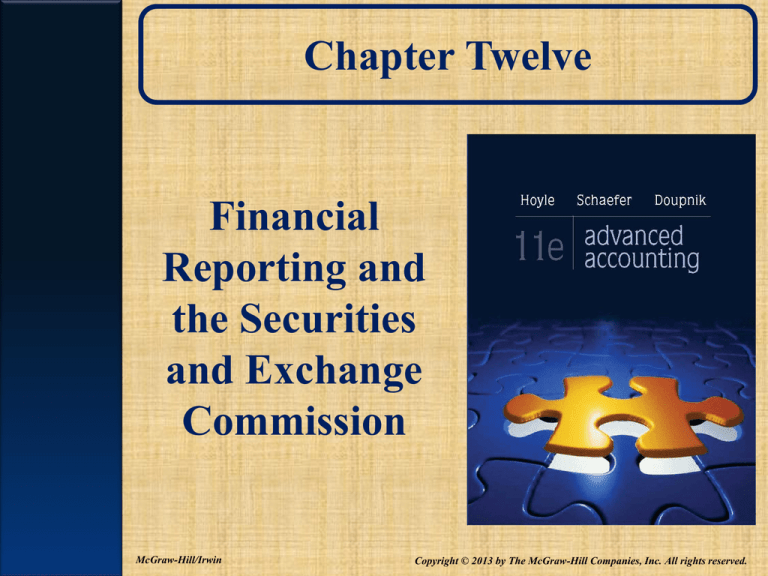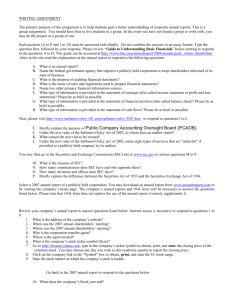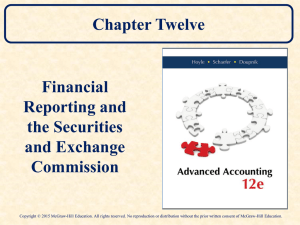
Chapter Twelve
Financial
Reporting and
the Securities
and Exchange
Commission
McGraw-Hill/Irwin
Copyright © 2013 by The McGraw-Hill Companies, Inc. All rights reserved.
LO 1
Securities and Exchange
Commission (SEC)
Independent
Agency of the
Federal
Government
Direct authority
Applies to Publicly
Held
Companies
Established by the
Securities
Exchange Act of
1934.
SEC
Major Influence on
the Development of
US GAAP
Mandate is to
ensure that
complete and
reliable information
is available to
investors
12-2
LO 2
Federal Securities Laws
Spurred by the Great Depression following the
1929 Stock Market Crash, Congress enacted:
Securities Act of 1933
Securities Exchange
Act of 1934
Regulates the initial
offering of securities by a
company or underwriter.
Regulates the subsequent
trading of securities
through brokers and
exchanges.
The 1934 Act Established the SEC
12-3
Full and Fair Disclosure
Securities Act of
1933 New securities
must be registered
prior to public sale.
Public Utility Holding
Company Act of 1935
Requires registration of
interstate holding
companies of public
utilities.
Securities Exchange
Act of 1934
Requires continuous
reporting by publicly
traded companies.
Prohibits fraudulent
and unfair behavior.
12-4
Full and Fair Disclosure
In 2001 and 2002, corporate scandals shook
the confidence of investors in the reliability of
financial statement information
Causes included:
Greed of the corporate executives
Failure of corporate governance
Audit failures
Unreasonable market expectations
Overburdened SEC
12-5
The SEC’s Impact
on Financial Reporting
In addition to audited financial statements, Rule 14c3 of the 1934 Act requires the following to be
included in proxy statements sent to shareholders:
5-year summary of operations.
Description of the business’ activities.
3-year summary of industry segments.
Listing of company directors and executive officers.
Market price of the common stock for each quarter
of the last 2 years.
Restrictions on the company’s ability to pay
dividends.
MD&A
12-6
LO3
Corporate Scandals Led to
Sarbanes-Oxley in 2002
Enron:
Ken Lay received $152.7
million in the year
his firm collapsed,
zeroing out pensions
WorldCom:
Improperly Added
$9 Billion of
Income
Adelphia Communications’
founder “looted” the company of
over $2 Billion
12-7
Sarbanes-Oxley Act of 2002
Section 101
Creation of Public Company
Accounting Oversight Board
Under the oversight and enforcement authority
of the SEC , the Board is charged with:
Establishing auditing, quality control, and
independence standards.
Performing periodic inspections of registered
public accounting firms.
Could potentially replace the Auditing
Standards Board of the AICPA.
12-8
Sarbanes-Oxley Act of 2002
Section 101
Creation of Public Company
Accounting Oversight Board
Five members
Allows only 2 of the 5 to be CPAs, past or present.
Remaining 3 must NOT be accountants.
The Board is funded through mandatory fees
levied on all publicly traded companies.
Accounting firms, domestic and foreign, must
register with the Board and pay fees.
Registered firms are subject to periodic
inspections by the PCAOB.
12-9
Sarbanes-Oxley Act of 2002
Auditor Independence
To ensure future independence of audit firms,
some previously common concurrent services
are now prohibited.
Bookkeeping services.
AIS design and implementation.
Appraisal or valuation services.
Internal audit outsourcing.
Management functions/Human Resource
Management.
Investment advising.
Legal services or expert services.
12-10
LO 4
SEC’s Authority over GAAP
There are two basic documents which lay out
the requirements of the SEC:
Regulation S-K
Regulation S-X
Establishes
requirements for all
nonfinancial
information
contained in SEC
filings.
Prescribes the form
and content of the
financial
statements, and the
related notes and
schedules.
12-11
SEC’s Authority Over GAAP
The
Congress
FASB’s
The SEC
has
standards
allows the
assigned
can be
FASB to set
GAAPoverridden
GAAP.
setting
by the
authority
SEC.
Authority
only
extends
to
publicly
to the
traded companies.
SEC.
12-12
LO 5
Filings with the SEC
Legislation and regulations require registrants
to make numerous filings including these two
basic categories of filings
Registration
Statements
Periodic
Filings
12-13
Common SEC Registration
Statement Forms
Description
Usually used by new registrants when no other form is
S-1
prescribed.
Used by large companies with a significant following in the stock
S-3
market. Has reduced disclosure requirements.
Used for securities issued in connection with business
S-4
combination transactions.
S-8 Used for employee stock plans
S-11 Used by certain real estate companies
Form
12-14
LO 6
Registration Process
1. Registration Statements delivered to SEC
2. Review by Div. Of Corp. Finance
3. A deficiency letter sent to registrant
4. Approved after deficiencies are cleared
5. Once the registration is effective,
the securities can be sold.
Note: This process is both
time-consuming and expensive.
12-15
Periodic Filings with the SEC
Form 10-K
Annual report filed
within 90 days of fiscal
year-end.
Includes audited
financial statements.
Form 10-Q
Quarterly report filed
within 45 days of end of
quarter.
Financial statement are
unaudited.
Form 8-K
Used to disclose a unique or
significant happening,
within 15 days of the event.
12-16




